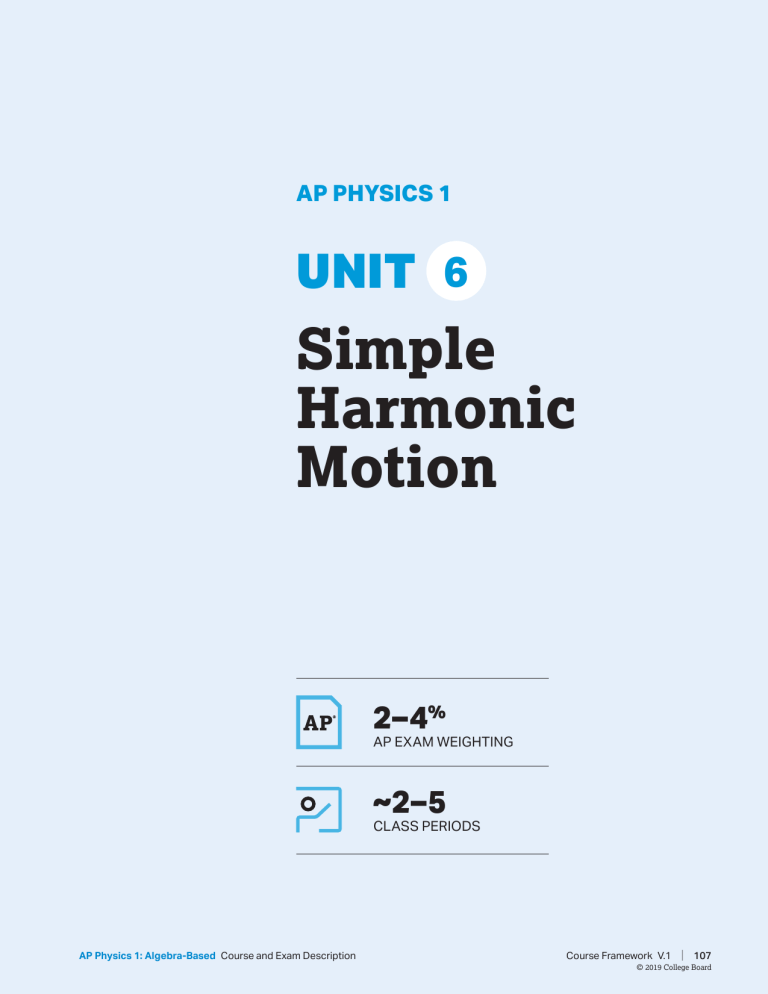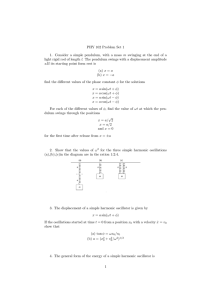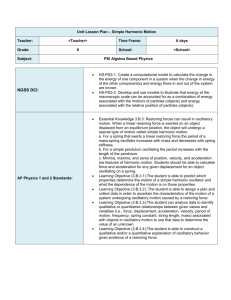
AP PHYSICS 1 UNIT 6 Simple Harmonic Motion 2–4% AP EXAM WEIGHTING ~2–5 CLASS PERIODS AP Physics 1: Algebra-Based Course and Exam Description Course Framework V.1 | 107 © 2019 College Board Remember to go to AP Classroom to assign students the online Personal Progress Check for this unit. Whether assigned as homework or completed in class, the Personal Progress Check provides each student with immediate feedback related to this unit’s topics and science practices. Personal Progress Check 6 Multiple-choice: ~20 questions Free-response: 2 questions §§ Experimental Design §§ Short Answer AP Physics 1: Algebra-Based Course and Exam Description Course Framework V.1 | 108 © 2019 College Board UNIT 6 2–4% AP EXAM WEIGHTING ~2–5 CLASS PERIODS Simple Harmonic Motion Unit Overview BIG IDEA 3 Force Interactions INT §§ How does a restoring force differ from a “regular” force? §§ How does the presence of restoring forces predict and lead to harmonic motion? §§ How does a spring cause an object to oscillate? §§ How can oscillations be used to make our lives easier? BIG IDEA 5 Conservation CON §§ How does the law of conservation of energy govern the interactions between objects and systems? §§ How can energy stored in a spring be used to create motion? In Unit 6, students will continue to use the same tools, techniques, and models that they have been using throughout this course. However, they will now use them to analyze a new type of motion: simple harmonic motion. Although simple harmonic motion is unique, students will learn that even in new situations, the fundamental laws of physics remain the same. Energy bar charts, as well as free-body diagrams, become increasingly important as students work toward determining which model is most appropriate for a given physical situation. Preconceptions—such as the relationship between the amplitude and period of oscillation—will also be addressed to provide students with a more nuanced awareness of simple harmonic motion. Students are expected to use the content knowledge they gained in the first five units to make and defend claims while also making connections in and across the content topics and big ideas. Because Unit 6 is the first unit in which students possess all the tools of force, energy, and momentum conservation, it’s important that teachers scaffold lessons to help them develop a better understanding of each fundamental physics principles as well as its limitations. Throughout this unit, students will be asked to create force, energy, momentum, and position versus time graphs for a single scenario and to make predictions based on their representations. Students will enhance their study of motion when they learn about oscillatory motion in Unit 10. Preparing for the AP Exam Some questions on AP Physics 1 Exam require students to identify more than one correct answer. Because these multiple-select questions can easily intimidate students, we highly recommend that they take the time to read the entire prompt. Students who jump right to the answers could be frustrated to find answer choices that are factually correct but do not complete the task. Remember: Students will only get credit if they choose all the correct answers. AP Physics 1: Algebra-Based Course and Exam Description Course Framework V.1 | 109 © 2019 College Board UNIT 6 Simple Harmonic Motion Enduring Understanding UNIT AT A GLANCE Class Periods Topic Science Practices 6.1 Period of Simple 2.2 The student can apply mathematical routines to quantities that describe natural phenomena. Harmonic Oscillators ~2–5 CLASS PERIODS 4.2 The student can design a plan for collecting data to answer a particular scientific question. 3.B 5.1 The student can analyze data to identify patterns or relationships. 6.2 The student can construct explanations of phenomena based on evidence produced through scientific practices. 6.4 The student can make claims and predictions about natural phenomena based on scientific theories and models. 7.2 The student can connect concepts in and across domain(s) to generalize or extrapolate in and/or across enduring understandings and/or big ideas. 6.2 Energy of a Simple Harmonic Oscillator 1.4 The student can use representations and models to analyze situations or solve problems qualitatively and quantitatively. 5.B 2.1 The student can justify the selection of a mathematical routine to solve problems. 2.2 The student can apply mathematical routines to quantities that describe natural phenomena. 6.4 The student can make claims and predictions about natural phenomena based on scientific theories and models. 7.2 The student can connect concepts in and across domain(s) to generalize or extrapolate in and/or across enduring understandings and/or big ideas. Go to AP Classroom to assign the Personal Progress Check for Unit 6. Review the results in class to identify and address any student misunderstandings. AVAILABLE RESOURCES FOR UNIT 6: §§ Classroom Resources > AP Physics 1 and 2 Inquiry-Based Lab Investigations: A Teacher’s Manual AP Physics 1: Algebra-Based Course and Exam Description Course Framework V.1 | 110 © 2019 College Board UNIT 6 Simple Harmonic Motion SAMPLE INSTRUCTIONAL ACTIVITIES The sample activities on this page are optional and are offered to provide possible ways to incorporate various instructional approaches the classroom. Teachers do not need to use these activities or instructional approaches and are free to alter or edit them. The examples below were developed in partnership with teachers from the AP community to share ways that they approach teaching some of the topics in this unit. Please refer to the Instructional Approaches section beginning on p. 173 for more examples of activities and strategies. Activity Topic 1 6.1 2 6.1 3 6.1 4 6.2 5 6.2 Sample Activity Desktop Experiment Task Have students determine the spring constant of a spring using (1) known masses and meterstick only and then (2) known masses and stopwatch only. Desktop Experiment Task Have students use a pendulum to measure the acceleration of gravity. Ask them to refine the experiment from single-trial calculation, to taking an average, to making a graph of linearized data. Predict and Explain Make a pendulum bob oscillate with the other end of the string “clamped” between your fingers. While the bob oscillates, pull the string through your fingers so that the string length is shortened. Before doing this, ask students what will happen to the period of the oscillation and the amplitude (measured in degrees), and then explain why the period decreases and the amplitude angle increases. Construct an Argument A cart wiggles on a horizontal spring. A blob of clay is dropped on the cart and sticks (could be when the cart is at the center or at one end). Ask students to explain what happened to the period, total energy, amplitude of motion, and maximum speed? Create a Plan Students choose a song and find its tempo (beats per minute). Students then must build a pendulum so that it swings back and forth on each beat. Students are then given a spring. They must find the spring’s constant and then find the amount of mass necessary to make the spring-mass oscillate on each beat. Unit Planning Notes Use the space below to plan your approach to the unit. AP Physics 1: Algebra-Based Course and Exam Description Course Framework V.1 | 111 © 2019 College Board UNIT 6 SCIENCE PRACTICES Mathematical Routines 2.2 The student can apply mathematical routines to quantities that describe natural phenomena. Simple Harmonic Motion TOPIC 6.1 Period of Simple Harmonic Oscillators Experimental Method 4.2 The student can design a plan for collecting data to answer a particular scientific question. Data Analysis 5.1 The student can analyze data to identify patterns or relationships. Argumentation Required Course Content ENDURING UNDERSTANDING 3.B Classically, the acceleration of an object interacting with other objects can be predicted by using a = F . m 6.2 The student can construct explanations of phenomena based on evidence produced through scientific practices. 6.4 The student can make claims and predictions about natural phenomena based on scientific theories and models. Making Connections 7.2 The student can connect concepts in and across domain(s) to generalize or extrapolate in and/or across enduring understandings and/or big ideas. LEARNING OBJECTIVE ESSENTIAL KNOWLEDGE 3.B.3.1 3.B.3 Predict which properties determine the motion of a simple harmonic oscillator and what the dependence of the motion is on those properties. [SP 6.4, 7.2] Restoring forces can result in oscillatory motion. When a linear restoring force is exerted on an object displaced from an equilibrium position, the object will undergo a special type of motion called simple harmonic motion. Examples include gravitational force exerted by Earth on a simple pendulum and mass-spring oscillator. 3.B.3.2 Design a plan and collect data in order to ascertain the characteristics of the motion of a system undergoing oscillatory motion caused by a restoring force. [SP 4.2] 3.B.3.3 Analyze data to identify qualitative and quantitative relationships between given values and variables (i.e., force, displacement, acceleration, velocity, period of motion, frequency, spring constant, string length, mass) associated with objects in oscillatory motion and use those data to determine the value of an unknown. [SP 2.2, 5.1] AP Physics 1: Algebra-Based Course and Exam Description a. For a spring that exerts a linear restoring force, the period of a mass-spring oscillator increases with mass and decreases with spring stiffness. b. For a simple pendulum, the period increases with the length of the pendulum and decreases with the magnitude of the gravitational field. c. Minima, maxima, and zeros of position, velocity, and acceleration are features of harmonic motion. Students should be able to calculate force and acceleration for any given displacement for an object oscillating on a spring. Relevant Equations: Tp = 2π l g Ts = 2π m k continued on next page Course Framework V.1 | 112 © 2019 College Board UNIT 6 Simple Harmonic Motion LEARNING OBJECTIVE ESSENTIAL KNOWLEDGE 3.B.3.4 3.B.3 Construct a qualitative and/ or quantitative explanation of oscillatory behavior given evidence of a restoring force. [SP 2.2, 6.2] Restoring forces can result in oscillatory motion. When a linear restoring force is exerted on an object displaced from an equilibrium position, the object will undergo a special type of motion called simple harmonic motion. Examples include gravitational force exerted by Earth on a simple pendulum and mass-spring oscillator. a. For a spring that exerts a linear restoring force, the period of a mass-spring oscillator increases with mass and decreases with spring stiffness. b. For a simple pendulum, the period increases with the length of the pendulum and decreases with the magnitude of the gravitational field. c. Minima, maxima, and zeros of position, velocity, and acceleration are features of harmonic motion. Students should be able to calculate force and acceleration for any given displacement for an object oscillating on a spring. Relevant Equations: Tp = 2π l g Ts = 2π m k AP Physics 1: Algebra-Based Course and Exam Description Course Framework V.1 | 113 © 2019 College Board UNIT 6 SCIENCE PRACTICES Modeling 1.4 The student can use representations and models to analyze situations or solve problems qualitatively and quantitatively. Simple Harmonic Motion TOPIC 6.2 Energy of a Simple Harmonic Oscillator Mathematical Routines 2.1 The student can justify the selection of a mathematical routine to solve problems. Required Course Content 2.2 The student can apply mathematical routines to quantities that describe natural phenomena. Argumentation ENDURING UNDERSTANDING 5.B The energy of a system is conserved. 6.4 The student can make claims and predictions about natural phenomena based on scientific theories and models. Making Connections 7.2 The student can connect concepts in and across domain(s) to generalize or extrapolate in and/or across enduring understandings and/or big ideas. LEARNING OBJECTIVE ESSENTIAL KNOWLEDGE 5.B.2.1 5.B.2 Calculate the expected behavior of a system using the object model (i.e., by ignoring changes in internal structure) to analyze a situation. Then, when the model fails, the student can justify the use of conservation of energy principles to calculate the change in internal energy due to changes in internal structure because the object is actually a system. [SP 1.4, 2.1] A system with internal structure can have internal energy, and changes in a system’s internal structure can result in changes in internal energy. [Physics 1 includes massspring oscillators and simple pendulums. Physics 2 includes charged objects in electric fields and examining changes in internal energy with changes in configuration.] continued on next page AP Physics 1: Algebra-Based Course and Exam Description Course Framework V.1 | 114 © 2019 College Board UNIT 6 Simple Harmonic Motion LEARNING OBJECTIVE ESSENTIAL KNOWLEDGE 5.B.3.1 5.B.3 Describe and make qualitative and/or quantitative predictions about everyday examples of systems with internal potential energy. [SP 2.2, 6.4, 7.2] A system with internal structure can have potential energy. Potential energy exists within a system if the objects within that system interact with conservative forces. 5.B.3.2 Make quantitative calculations of the internal potential energy of a system from a description or diagram of that system. [SP 1.4, 2.2] 5.B.3.3 Apply mathematical reasoning to create a description of the internal potential energy of a system from a description or diagram of the objects and interactions in that system. [SP 1.4, 2.2] a. The work done by a conservative force is independent of the path taken. The work description is used for forces external to the system. Potential energy is used when the forces are internal interactions between parts of the system. b. Changes in the internal structure can result in changes in potential energy. Examples include mass-spring oscillators and objects falling in a gravitational field. c. The change in electric potential in a circuit is the change in potential energy per unit charge. [In Physics 1, only in the context of circuits] Relevant Equations: Tp = 2π l g Ts = 2π m k 2 1 U s = kx 2 ΔU g = mg Δy 5.B.4.1 5.B.4 Describe and make predictions about the internal energy of systems. [SP 6.4, 7.2] The internal energy of a system includes the kinetic energy of the objects that make up the system and the potential energy of the configuration of the objects that make up the system. 5.B.4.2 Calculate changes in kinetic energy and potential energy of a system using information from representations of that system. [SP 1.4, 2.1, 2.2] a. Since energy is constant in a closed system, changes in a system’s potential energy can result in changes to the system’s kinetic energy. b. The changes in potential and kinetic energies in a system may be further constrained by the construction of the system. AP Physics 1: Algebra-Based Course and Exam Description Course Framework V.1 | 115 © 2019 College Board THIS PAGE IS INTENTIONALLY LEFT BLANK.




